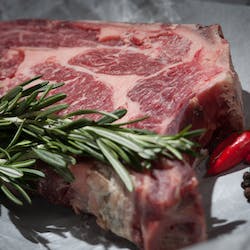
Level 1:
Once upon a time, we learned about a yummy food called steak. Steak comes from cows. You can cook it in so many ways! Some people like it juicy, some like it all done. You can even add yummy things on top to make the steak yummier!
Now, we get to tell you about all the great ways to eat steak. We will tell you about how to cook it and what to eat with it. You can be a great steak cooker and eater!
A lot of people love steak. They come to steak places. They have fun eating and trying different types. Some people say it’s not nice. They say it’s not healthy. But you know what? Eating steak can be good for you if you eat it the right way!
Level 2:
Steak is not just a food; it’s a culinary experience. Originating from beef, steaks can be cooked and savored in a plethora of ways. Whether you prefer your steak bloody, mid-cooked or well-done, there’s a technique out there to perfect your preference.
But that’s just the start. Steaks come in multiple cuts and styles, and with each cut, you can experiment with different toppings, seasonings, and pairings. By knowing and mastering these variables, you can enhance the steak-eating experience.
Interestingly, steakhouses have gained enormous popularity worldwide. People gather from all corners to experience the thrill of barbecue, sample different types of steak, and enjoy the overall gastronomical pleasure.
However, some critics pinpoint steak’s nutritional impact, questioning its culinary status considering health variables. But like any food, when consumed in proper portions and in the right way, steak can fit into a balanced diet.
Full Story:
Steak is undeniably a gastronomic delight for many. Originating from beef, steaks can be presented in an array of forms and flavors. Steak preparation depends significantly on personal preferences - ranging from rare, with the insides still bloody, to well-done, thoroughly cooked all the way through. It’s a culinary journey that starts at the butcher’s section and ends at your plate.
One of the exciting aspects of enjoying steak is the variety of cuts to choose from, such as ribeye, porterhouse, T-bone, filet mignon, and many others. Each cut boasts a unique flavor profile and texture, offering a rich tapestry of experiences to the steak appreciator.
The artistry of steak preparation doesn’t stop there. You can also experiment with different toppings - like a pat of garlic butter, crumbled blue cheese, or a simple dusting of coarse salt and cracked black pepper. Pairings are equally important - with wines, side dishes, and sauces playing a prominent role.
Over the years, steakhouses have grown increasingly popular as culinary hotspots. These eateries offer a unique gastronomical experience, allowing patrons to savor a diverse range of steak cuts, cooking styles, and pairing options. Partaking in these meaty adventures, steak-lovers from all across the globe relish the intricate twists and turns of this timeless culinary masterpiece.
However, the rise in steak popularity has also drawn some criticism, particularly from nutritional and health standpoints. Critics express concerns about the health impacts of consuming large quantities of red meat. They argue that consuming such a rich food in significant amounts may contribute to health issues.
On the counter, steak enthusiasts and dietitians advocate for a balanced approach. They imply that steak can be part of a healthy diet when consumed in moderation and is coupled with a variety of other food groups.
Regardless of the controversy, steak continues to hold a much-revered place in the world of gastronomy. The artistry involved in preparing and consuming the perfect steak - from choosing the right cut and cooking style to the ultimate pairing with wine or side dishes - forms an essential part of many culinary explorations.
Questions:
Question: What is steak?
Answer: Steak is a prime cut of beef that’s usually grilled but can also be pan-fried or broiled. It comes in various types and can be cooked to different degrees, from rare to well-done.
Question: What are the common ways of preparing a steak?
Answer: Common ways of preparing steak range from grilling to pan-frying or broiling. It can be seasoned with various toppings - like garlic butter, blue cheese, or just a simple pinch of salt and pepper.
Question: What’s the role of steakhouses?
Answer: Steakhouses offer a unique gastronomical experience, allowing patrons to savor a diverse range of steak cuts, cooking styles, and pairing options. These eateries have become popular culinary hotspots that attract steak-lovers from across the globe.
Question: What is the controversy around eating steak?
Answer: Critics of steak consumption often raise concerns about the health impacts of consuming large quantities of red meat. They argue that such a diet may contribute to serious health issues. However, many believe moderation is key and steak can form part of a healthy, balanced diet.
Fill in the Blanks:
culinary, delight, beef, grilled, cooked, flavors, experience, plethora, cuts, seasonings, experiment, steakhouses, gastronomical, wine, pairings, dietitians, moderation, variety, gastronomy, butcher, portion, preparation, nutritional, intrinsic.
Steak: The Ultimate Guide to Savouring This Culinary Delight
Steak is undeniably a gastronomic _______ for many.
Steak preparation depends significantly on _______ preferences - ranging from rare, with the insides still bloody, to well-done, thoroughly cooked all the way through.
One of the exciting aspects of enjoying steak is the _______ of cuts to choose from.
You can also experiment with different toppings - like a pat of garlic butter, crumbled blue cheese, or a simple dusting of coarse salt and cracked black pepper.
Pairings are equally important - with _______, side dishes, and sauces playing a prominent role.
Over the years, _______ have grown increasingly popular as culinary hotspots.
Critics express concerns about the health impacts of consuming large quantities of red meat.
They imply that steak can be part of a healthy diet when consumed in _______ and is coupled with a _______ of other food groups.
Vocabulary:
Culinary: Connected with cooking or kitchens.
Delight: A feeling of extreme pleasure or satisfaction.
Beef: The meat obtained from cows.
Grilled: Cooked by radiant heat.
Flavors: The distinctive taste of a food or drink.
Experience: An event or a series of events participated in or lived through.
Plethora: An abundance; a great quantity.
Cuts: The act of cutting, in particular the division of meat into pieces.
Seasonings: A substance added to food to enhance the flavor.
Experiment: A test, trial, or tentative procedure; an act or operation for the purpose of discovering something unknown or of testing a principle, supposition, etc.
Steakhouses: A restaurant that specializes in serving steak and other cuts of meat.
Gastronomical: Pertaining to the art or science of good eating.
Wine: An alcoholic beverage made from fermented grapes or other fruits.
Pairings: The act of combining various foods and drinks for flavor compatibility.
Dietitians: An expert on diet and nutrition.
Moderation: The quality of doing something within reasonable limits.
Variety: The state of being varied or diversified.
Gastronomy: preparing and eating good food.
Butcher: A person who slaughters or dresses meat for market.
Portion: A part of any whole, either separated from or integrated with it.
Preparation: The action or process of making something ready for use or service or of getting ready for some occasion, test, or duty.
Nutritional: Of or relating to the process of providing or obtaining the food necessary for health and growth.




